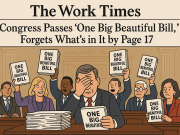As Donald Trump sets the stage for his economic agenda, one of his core principles remains unchanged: the revitalization of American industry through an aggressive “America First” strategy. With an emphasis on domestic production, supply chain reshoring, and “Buy American” initiatives, Donald Trump’s policies could offer both opportunities and challenges for small businesses across the country.
While his policies aim to boost local manufacturing, ensure job creation, and reduce dependence on foreign imports, questions remain about their long-term impact on small businesses and entrepreneurs. Could these measures truly ignite a new era of prosperity for small manufacturers and suppliers, or will they face an uphill battle against rising costs and larger competitors?
What to Expect from Trump’s America-First Economic Strategy
The core of Trump’s economic revival plan revolves around strengthening domestic industries, encouraging Americans to prioritize homegrown products, and securing U.S. supply chains. His approach is based on a mix of trade policies, tax incentives, and federal procurement initiatives that aim to position American businesses as the backbone of the national economy.
Key Policy Pillars:
- “Buy American” Mandates
- Trump’s administration previously expanded federal procurement requirements to prioritize American-made goods for government contracts. His new agenda is expected to double down on these mandates, offering small manufacturers new avenues to supply essential goods to federal agencies, from infrastructure materials to technology.
- Tariffs on Foreign Imports
- A continuation of tariffs on countries like China aims to reduce reliance on imported goods. For small businesses, this could mean less foreign competition and increased demand for locally produced alternatives. However, higher import costs on raw materials could also increase production expenses.
- Supply Chain Reshoring Efforts
- Trump’s policies push corporations to bring their manufacturing operations back to the U.S., which could foster the growth of local suppliers and service providers. Small businesses could benefit from being integrated into domestic supply chains previously reliant on overseas suppliers.
- Tax Breaks and Incentives for American Businesses
- Expect a resurgence of corporate tax cuts and incentives aimed at encouraging businesses to expand domestically, invest in new technologies, and hire American workers. Small business owners stand to gain from deductions, credits, and accelerated depreciation policies.
Hopeful Aspects for Small Businesses
For small businesses and entrepreneurs, Trump’s America-first approach presents several potential advantages that could fuel growth and innovation. The administration’s focus on self-reliance and domestic capacity-building provides an opportunity for businesses to scale operations and participate in a national movement toward economic independence.
1. Increased Government Contracts for American-Made Products
Government procurement represents a massive opportunity for small businesses that manufacture industrial equipment, construction materials, pharmaceuticals, and technology products. With “Buy American” mandates strengthening, small manufacturers could access billions in federal spending, creating long-term stability and enabling growth.
Example:
The Department of Defense (DoD) and infrastructure programs are expected to ramp up their reliance on domestic suppliers, creating lucrative contract opportunities for small businesses in industries such as construction, defense, and healthcare equipment manufacturing.
2. Supply Chain Reshoring: A Boon for Local Suppliers
As large corporations move production back to the U.S. to comply with Trump’s policies, small businesses could become key players in restructured domestic supply chains. Reshoring efforts could lead to:
- Increased demand for local materials and components from smaller suppliers.
- Opportunities for subcontracting and partnerships with larger firms.
- Regional economic revitalization as local businesses expand to support the changing supply chain.
Example:
The automotive and technology sectors, heavily reliant on offshore manufacturing, may see a gradual shift toward U.S.-based component suppliers, benefiting smaller manufacturers specializing in niche markets.
3. Job Creation and Economic Growth
Small businesses are often at the heart of local economies, and Trump’s policies could stimulate job creation in communities hit hardest by outsourcing. With more production happening on U.S. soil, small businesses will require a larger workforce, opening up job opportunities and fueling economic activity in cities and rural areas alike.
Key Industries to Watch:
- Manufacturing and textiles
- Agricultural processing
- Energy and infrastructure development
Potential Impact:
An increase in hiring could result in higher consumer spending, local economic revitalization, and reduced unemployment.
Challenges to Watch for Small Businesses
Despite the optimistic outlook, small businesses must prepare for the potential challenges that Trump’s America-first policies could bring. While prioritizing domestic production is appealing, the economic realities of higher costs and competitive pressures cannot be ignored.
1. Rising Production Costs
One of the biggest challenges facing small businesses under these policies is the rising cost of raw materials and labor. As tariffs increase the price of imported materials such as steel, aluminum, and electronics, businesses that rely on these inputs may struggle to maintain profitability.
Potential Consequences:
- Higher operating costs could result in price increases, making U.S. goods less competitive.
- Small businesses may have difficulty absorbing these costs compared to larger competitors with greater financial resources.
Example:
A small-scale machinery manufacturer may see an increase in steel prices due to tariffs, forcing them to either raise prices or absorb the costs, potentially eroding margins.
2. Retaliatory Tariffs and Global Market Risks
If Trump’s policies lead to trade tensions with other countries, small businesses engaged in export markets may suffer from retaliatory tariffs, limiting their ability to sell goods abroad. Export-dependent small manufacturers, particularly those in agriculture and high-tech sectors, could face reduced market access and revenue declines.
Industries at Risk:
- Agriculture (soybeans, dairy, meat)
- Manufacturing (automobile parts, machinery)
Mitigation Strategies:
Businesses must consider diversifying supply chains and seeking new markets to offset potential losses from trade restrictions.
3. Competition with Larger Corporations
While Trump’s policies aim to empower small businesses, larger corporations are often better positioned to capitalize on tax breaks, subsidies, and contract opportunities. Small businesses may struggle to compete for federal contracts or supply chain integration opportunities against bigger, well-established players with deeper resources and lobbying power.
Possible Solutions:
- Government programs should offer dedicated support and funding to ensure small businesses aren’t sidelined in the bidding process.
- Partnerships and cooperative alliances between small firms can create stronger bargaining power and enhance competitiveness.
Conclusion: A Mixed Bag of Opportunities and Challenges
Trump’s “Made in America 2.0” vision holds significant promise for small businesses looking to grow and thrive in a revitalized domestic economy. Increased government contracts, supply chain reshoring, and job creation offer exciting possibilities for entrepreneurs and manufacturers eager to capitalize on a renewed focus on American production.
However, small businesses must navigate challenges such as rising costs, international trade risks, and competition with larger firms. Strategic planning, adaptability, and leveraging government support programs will be crucial for small businesses to truly benefit from these policies. As the political landscape evolves, it remains to be seen how effectively these America-first measures will translate into sustainable long-term growth for small enterprises. Small business owners should stay informed and proactive in positioning themselves for success in this evolving economic environment.




























